Muslin – A Modern Fusion Of Fashion
The Timeless Elegance of Muslin with Chikankari: A Perfect Blend of Tradition and Artistry
Muslin with Chikankari is a mesmerizing fusion of two traditional art forms that have stood the test of time. Originating from different parts of the world, muslin fabric and Chikankari embroidery represent centuries of cultural heritage and craftsmanship. This perfect combination not only exudes elegance and charm but also reflects the rich history of Indian textile arts. In this article, we will explore the fascinating history, craftsmanship, and contemporary relevance of Muslin with Chikankari, highlighting why it remains a favorite choice for fashion enthusiasts and textile lovers alike.
What is Muslin Fabric?
Muslin is a fine, lightweight cotton fabric with a soft texture and smooth finish. Historically, muslin originated in the Middle East, specifically in the region of Mosul (modern-day Iraq), where it was produced for centuries. The fabric quickly became popular across the world, especially in Europe and Asia, due to its breathable nature and exquisite softness.
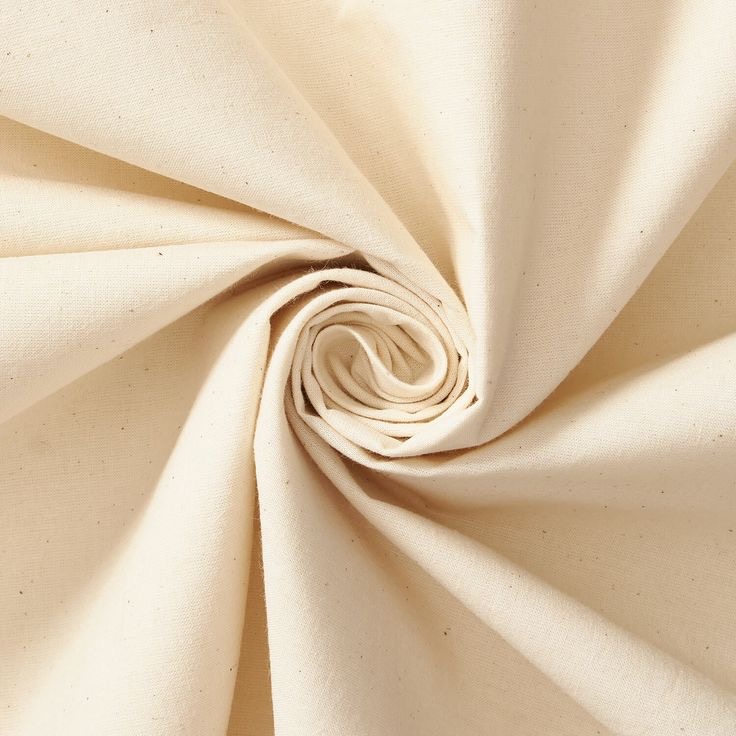
Muslin fabric is known for its versatility, as it can be woven in various thicknesses. The lighter versions are often used for making garments like dresses, sarees, and dupattas, while thicker varieties are suitable for home décor, curtains, and upholstery. Its luxurious feel and delicate nature make muslin an ideal canvas for various embroidery techniques, including the traditional Indian art of Chikankari.
The Art of Chikankari Embroidery
Chikankari is an intricate hand-embroidery technique that originated in Lucknow, India, during the Mughal era. The word “Chikan” means “embroidery” in Hindi, and “Chikankari” refers to the delicate, needlework-based art form. The art of Chikankari involves creating intricate patterns using thread, beads, sequins, and sometimes even mirrors to embellish fabric. The designs are typically floral, paisley, and geometric, showcasing the detailed craftsmanship and skill of the artisan.
Chikankari embroidery is usually done on lightweight fabrics like muslin, chiffon, silk, and cotton. Muslin, being a soft and smooth fabric, provides the perfect backdrop for Chikankari, allowing the embroidery to stand out and capture attention.
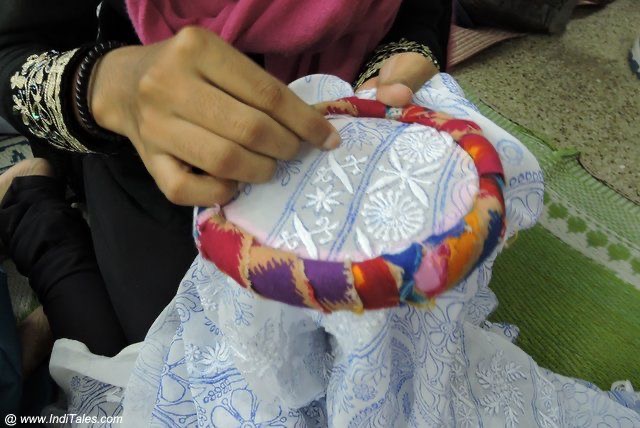
The Process of Creating Muslin with Chikankari
Creating Muslin with Chikankari is a painstakingly meticulous process that involves several steps, each carried out with precision and skill. Here’s an overview of the steps involved:
- Fabric Selection: The first step in the process is choosing the right quality of muslin fabric. It must be soft, smooth, and of appropriate weight to carry the intricate embroidery without being too stiff or too delicate.
- Design Creation: The Chikankari design is carefully planned. Skilled artisans usually draw the motifs onto the muslin fabric using a thin outline of chalk or carbon paper. Popular Chikankari motifs include flowers, vines, and paisleys, but the designs can vary based on the creator’s preferences.
- Embroidery: Once the design is transferred onto the fabric, the embroidery work begins. Skilled artisans use a variety of stitches such as the “phool” (flower) stitch, “jaali” (net) stitch, and “boota” (paisley) stitch to create the intricate patterns. The threads used are typically white or in soft pastel shades, allowing the embroidery to remain subtle and elegant.
- Finishing Touches: After the embroidery is complete, the fabric is washed to remove any remaining chalk markings. The Chikankari designs are then carefully checked for consistency and quality. The final piece is now ready for use in clothing, home décor, or other textile applications.
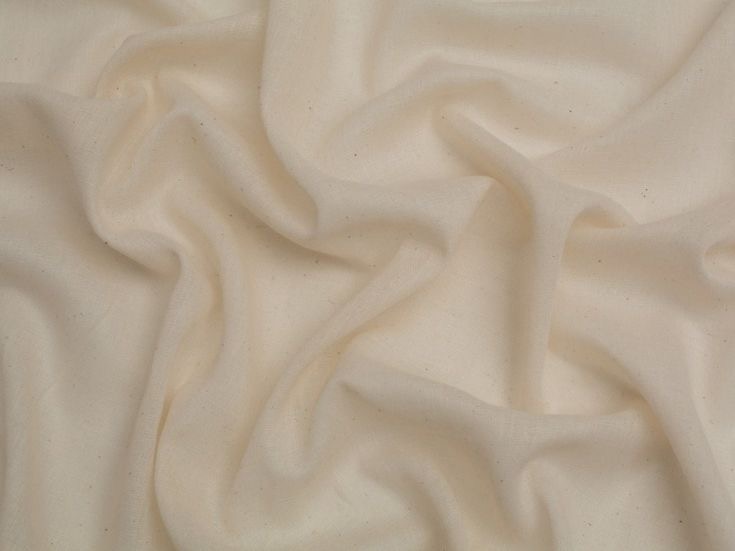
Types of Chikankari Stitches on Muslin Fabric
Several types of Chikankari stitches can be used on muslin fabric, each contributing to the overall design’s texture and aesthetic appeal. Some of the most popular Chikankari stitches include:
- Phool (Flower) Stitch: This is one of the most common Chikankari stitches, creating a beautiful floral design. It is achieved by working in a circular motion, using long and short stitches to form the petals of a flower.
- Jaali (Net) Stitch: This stitch creates a lace-like effect, resembling a net. It is often used in the background of designs to add texture and depth.
- Tari (Shadow) Stitch: This is a delicate stitch that creates a shadow effect on the fabric, giving it a subtle, ethereal quality.
- Murri Stitch: A unique stitch that involves creating small raised bumps on the fabric, often used for adding dimension to a Chikankari design.
- Bakhia (Backstitch) and Herringbone Stitch: These are used to outline shapes and add definition to the embroidery.
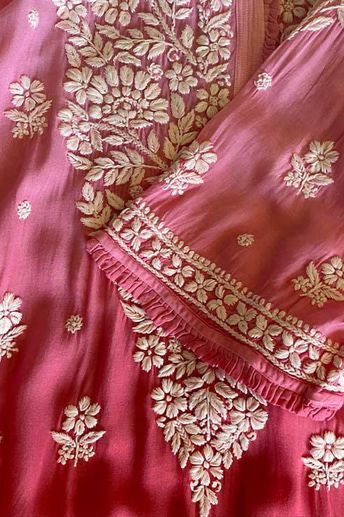
The Role of Muslin with Chikankari in Modern Fashion
Today, Muslin with Chikankari is not only a favorite choice for traditional clothing like sarees and salwar kameez but also plays a significant role in contemporary fashion. The blend of Muslin’s softness and the artistry of Chikankari creates pieces that are timeless yet modern. Designers and fashion houses have embraced this fusion, showcasing Muslin with Chikankari in their collections, ranging from casual wear to haute couture.
Some ways Muslin with Chikankari is being used in modern fashion include:
- Sarees and Dupattas: Muslin sarees with Chikankari embroidery are particularly popular in bridal wear. The combination of intricate threadwork and the lightweight feel of Muslin creates a flowing, ethereal look, perfect for special occasions.
- Tops and Dresses: Muslin with Chikankari is also being used to create contemporary blouses, tops, and dresses. The elegance of the embroidery combined with the comfort of Muslin fabric makes for stunning, wearable pieces that can be dressed up or down.
- Chikan Kurtis: The classic Chikan kurti is another popular garment that often uses Muslin as the base fabric. These kurtis, adorned with delicate Chikankari embroidery, are perfect for everyday wear, blending traditional and modern sensibilities.
- Home Décor: Muslin with Chikankari is not limited to fashion alone. Many interior designers use this beautiful fabric for items such as curtains, cushion covers, and bedspreads. The embroidery adds a sophisticated touch to any room.
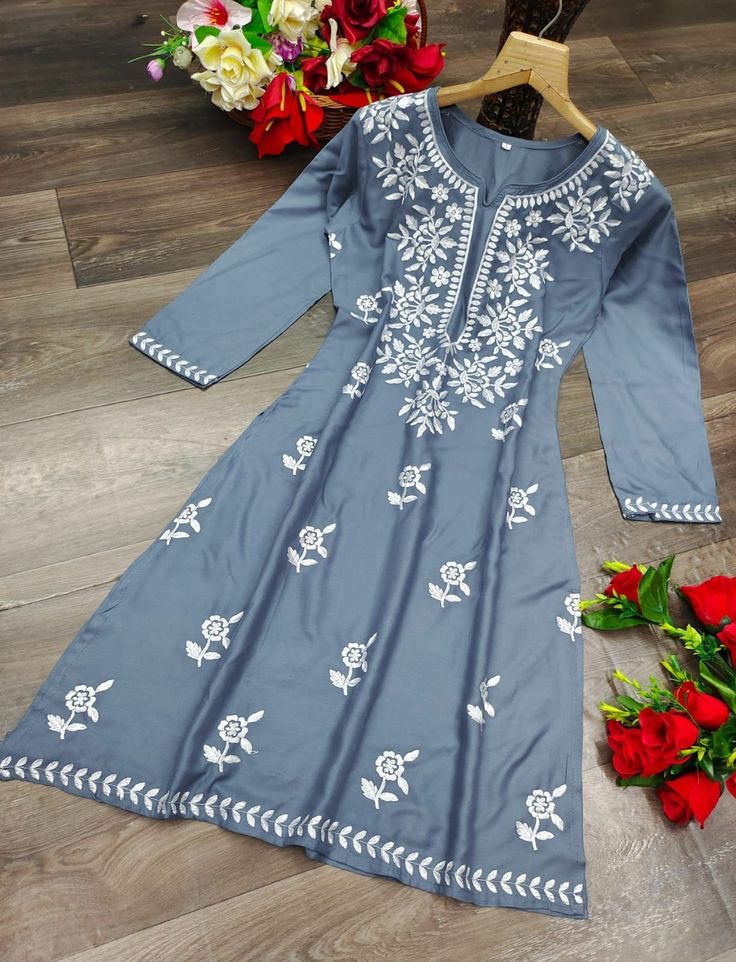
Caring for Muslin with Chikankari
To ensure that Muslin with Chikankari retains its beauty and lasts for years, proper care is essential. Here are some tips for caring for Muslin with Chikankari:
- Gentle Hand Wash: Muslin fabric is delicate, so it is advisable to hand wash it in cool water with a mild detergent. Avoid scrubbing or wringing the fabric, as this can damage the embroidery.
- Avoid Direct Sunlight: Prolonged exposure to direct sunlight can cause the colors of the Chikankari embroidery to fade. It is best to dry the fabric in the shade.
- Iron with Caution: When ironing Muslin with Chikankari, ensure that the fabric is slightly damp and use a low-heat setting to avoid damaging the delicate embroidery.
- Store Properly: To preserve the fabric and embroidery, store Muslin with Chikankari in a cool, dry place. Avoid hanging it for long periods, as this could distort the shape.
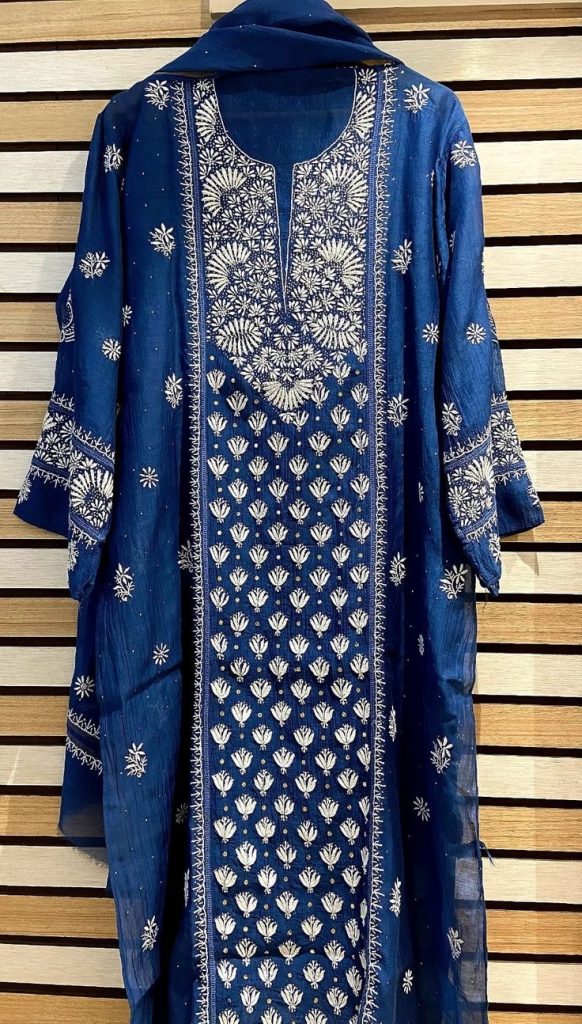
Muslin with Chikankari is more than just a fabric; it is a representation of the timeless craftsmanship, heritage, and cultural artistry that has been passed down through generations. The fusion of Muslin’s lightness and Chikankari’s intricate embroidery creates a fabric that is both luxurious and practical. Whether in traditional garments or contemporary designs, Muslin with Chikankari continues to be a sought-after fabric, cherished by fashion lovers and textile enthusiasts alike.
This enchanting combination of Muslin and Chikankari is sure to remain relevant in the world of fashion, bridging the gap between tradition and modernity, offering a glimpse into India’s rich textile legacy, and continuing to inspire new generations of artisans and designers.



Add comment